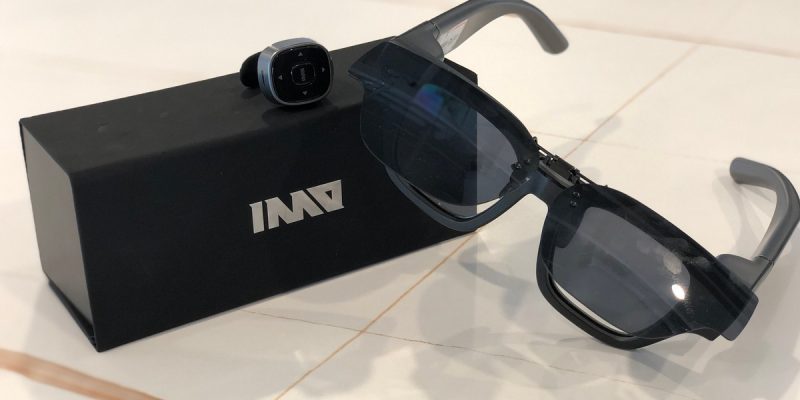Many tech companies these days are dipping their toes into virtual and/or augmented reality. We have devices like Sony’s PlayStation VR, then we have Valve’s Vive headset that was developed with HTC, and we also have Microsoft’s HoloLens. More recently, Apple also announced their own take with the Apple Vision Pro.
That being said, the problem with some of these devices is that they generally require users to tether the headset to something. In some cases, it would be to a PC or console, and for some, a smartphone or tablet.
We don’t see anything wrong with this setup because in some cases, a PC or console might be more powerful and can handle all the processing. The downside is that it limits the use of these headsets to a fixed location, like your home, office, or studio. This means that we’re still quite a bit aways from a future where we can all freely walk around with mixed reality headsets strapped to our face.
Enter the INMO Air2.
Lightweight, wireless operation

These are a pair of AR glasses that have been designed to be wireless and can operate independently of other devices, meaning that everything is processed and happens within the glasses themselves.
This is made possible thanks to the company’s use of the ZiGuang ZhanRui AI chip, a quad-core chipset clocking in at 1.8GHz. It also comes with 2GB of RAM and 32GB of storage, and it is also powered by the company’s own IMOS 2.0 operating system.
What this means is that everything you need to power the glasses is within the glasses itself. There will be no need for users to tether themselves to a PC or console, or connect it to a phone, so even if you don’t have your mobile device on you, the INMO Air2 will work just fine, giving users a true sense of freedom.
Now, some of you might think that because with all this tech stuffed into the glasses that it would end up being bulky and heavy, but that’s not the case. The INMO Air2 actually weighs a little under 100g, thanks to its materials which are a mix of plastic and aluminum. This allows the user to wear the glasses for an extended period of time and not feel too fatigued.
After nearly 3-4 years of iteration, INMO has finally achieved an ultra-small circuit board that can be folded and placed in the temple and now the process has reached 12 layers, which is basically a top design in terms of hardware technology on the market, ” says Mr.Yang, CEO of INMO. “Meanwhile, through exploring many chip options, INMO is the first company in the industry to use a watch chip to make AR glasses.
INMO has also included a bunch of nose pads that users can choose from to find the one that fits them the best and feels the most comfortable.
Apps for work and travel

If there is one problem that Apple currently faces with its Vision Pro headset is the current lack of an ecosystem, which means that save for very specific use case scenarios, it’s not really for the average consumer, but that won’t be an issue with the INMO Air2.
The company has ensured that the headset comes with a bunch of very useful and functional apps that can be used in your daily lives.
For example, one of the most obvious uses of the headset would be to watch videos and movies. Users will be able to stream video content from platforms such as YouTube or TikTok. Alternatively, they can also pair their phone with the headset and use it to mirror content from their mobile devices.
The headset isn’t just for personal entertainment uses either. If you’re someone who deals with people who speak a different language, the INMO Air2 has a built-in translator where you can see the translation overlaid on the display of the glasses. So, instead of having to pull up a phone to translate, you can look the person in the eye and continue your conversation.
It can also act as a teleprompter which is handy when giving presentations because it means you spend less time looking at the slides and more on your audience. Users can also join video conference calls, answer their phones, and more.
Other potential uses for the INMO Air2 include navigation, where you can wear it while walking and get turn-by-turn navigation. You can also use it as a personal training tool, where you can watch online tutorials or personal training sessions and feel like the tutor is right in front of you!
Support for AI
AI is all the buzz right now, especially with OpenAI’s ChatGPT demonstrating how far along the tech has come and how useful it can be. To that end, INMO has actually included their own INMO GPT app which is integrated with OpenAI’s GPT model.
This is probably one of the headset’s coolest features because with AI right at your fingertips, users will be able to ask it for information at any given time and have the answers displayed quite literally in front of your eyes.
This is something we’ve mostly seen only in superhero and sci-fi movies, but INMO is now making it a reality.
Kickstarter campaign
So far, everything INMO claims its Air2 is capable of is very impressive, not to mention very interesting and practical compared to the headsets we’ve seen from other tech giants. If you’re interested in getting your hands on one, INMO is actually running a Kickstarter campaign for the Air2 headset.
Users who are interested can back it by pledging $599 which will include both the INMO Air2 and Ring. This is a 25% discount on its RRP which would cost you $799. This is a whole sight cheaper than the other headsets we’re seeing out there, so if you want to see (pun intended) what the future looks like, then the INMO Air2 is definitely worth taking a look at.













Comments